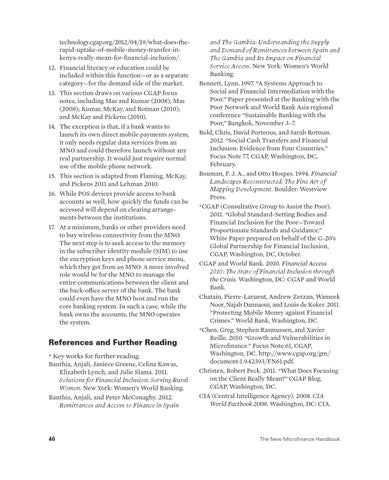12.
13.
14.
15. 16.
17.
technology.cgap.org/2012/04/19/what-does-therapid-uptake-of-mobile-money-transfer-inkenya-really-mean-for-financial-inclusion/. Financial literacy or education could be included within this function—or as a separate category—for the demand side of the market. This section draws on various CGAP focus notes, including Mas and Kumar (2008); Mas (2008); Kumar, McKay, and Rotman (2010); and McKay and Pickens (2010). The exception is that, if a bank wants to launch its own direct mobile payments system, it only needs regular data services from an MNO and could therefore launch without any real partnership. It would just require normal use of the mobile phone network. This section is adapted from Flaming, McKay, and Pickens 2011 and Lehman 2010. While POS devices provide access to bank accounts as well, how quickly the funds can be accessed will depend on clearing arrangements between the institutions. At a minimum, banks or other providers need to buy wireless connectivity from the MNO. The next step is to seek access to the memory in the subscriber identity module (SIM) to use the encryption keys and phone service menu, which they get from an MNO. A more involved role would be for the MNO to manage the entire communications between the client and the back-office server of the bank. The bank could even have the MNO host and run the core banking system. In such a case, while the bank owns the accounts, the MNO operates the system.
References and Further Reading * Key works for further reading.
Banthia, Anjali, Janiece Greene, Celina Kawas, Elizabeth Lynch, and Julie Slama. 2011. Solutions for Financial Inclusion: Serving Rural Women. New York: Women’s World Banking. Banthia, Anjali, and Peter McConaghy. 2012. Remittances and Access to Finance in Spain
46
and The Gambia: Understanding the Supply and Demand of Remittances between Spain and The Gambia and Its Impact on Financial Service Access. New York: Women’s World Banking. Bennett, Lynn. 1997. “A Systems Approach to Social and Financial Intermediation with the Poor.” Paper presented at the Banking with the Poor Network and World Bank Asia regional conference “Sustainable Banking with the Poor,” Bangkok, November 3–7. Bold, Chris, David Porteous, and Sarah Rotman. 2012. “Social Cash Transfers and Financial Inclusion: Evidence from Four Countries.” Focus Note 77, CGAP, Washington, DC, February. Bouman, F. J. A., and Otto Hospes. 1994. Financial Landscapes Reconstructed: The Fine Art of Mapping Development. Boulder: Westview Press. *CGAP (Consultative Group to Assist the Poor). 2011. “Global Standard-Setting Bodies and Financial Inclusion for the Poor—Toward Proportionate Standards and Guidance.” White Paper prepared on behalf of the G-20’s Global Partnership for Financial Inclusion, CGAP, Washington, DC, October. CGAP and World Bank. 2010. Financial Access 2010: The State of Financial Inclusion through the Crisis. Washington, DC: CGAP and World Bank. Chatain, Pierre-Laruent, Andrew Zerzan, Wameek Noor, Najah Dannaoui, and Louis de Koker. 2011. “Protecting Mobile Money against Financial Crimes.” World Bank, Washington, DC. *Chen, Greg, Stephen Rasmussen, and Xavier Reille. 2010. “Growth and Vulnerabilities in Microfinance.” Focus Note 61, CGAP, Washington, DC. http://www.cgap.org/gm/ document-1.9.42393/FN61.pdf. Christen, Robert Peck. 2011. “What Does Focusing on the Client Really Mean?” CGAP Blog, CGAP, Washington, DC. CIA (Central Intelligence Agency). 2008. CIA World Factbook 2008. Washington, DC: CIA.
The New Microfinance Handbook
